Ever had a DIY project go awry with spray paint ending up on your beloved wood pieces? How do you remove it without causing damage? Dive in to discover proven methods!
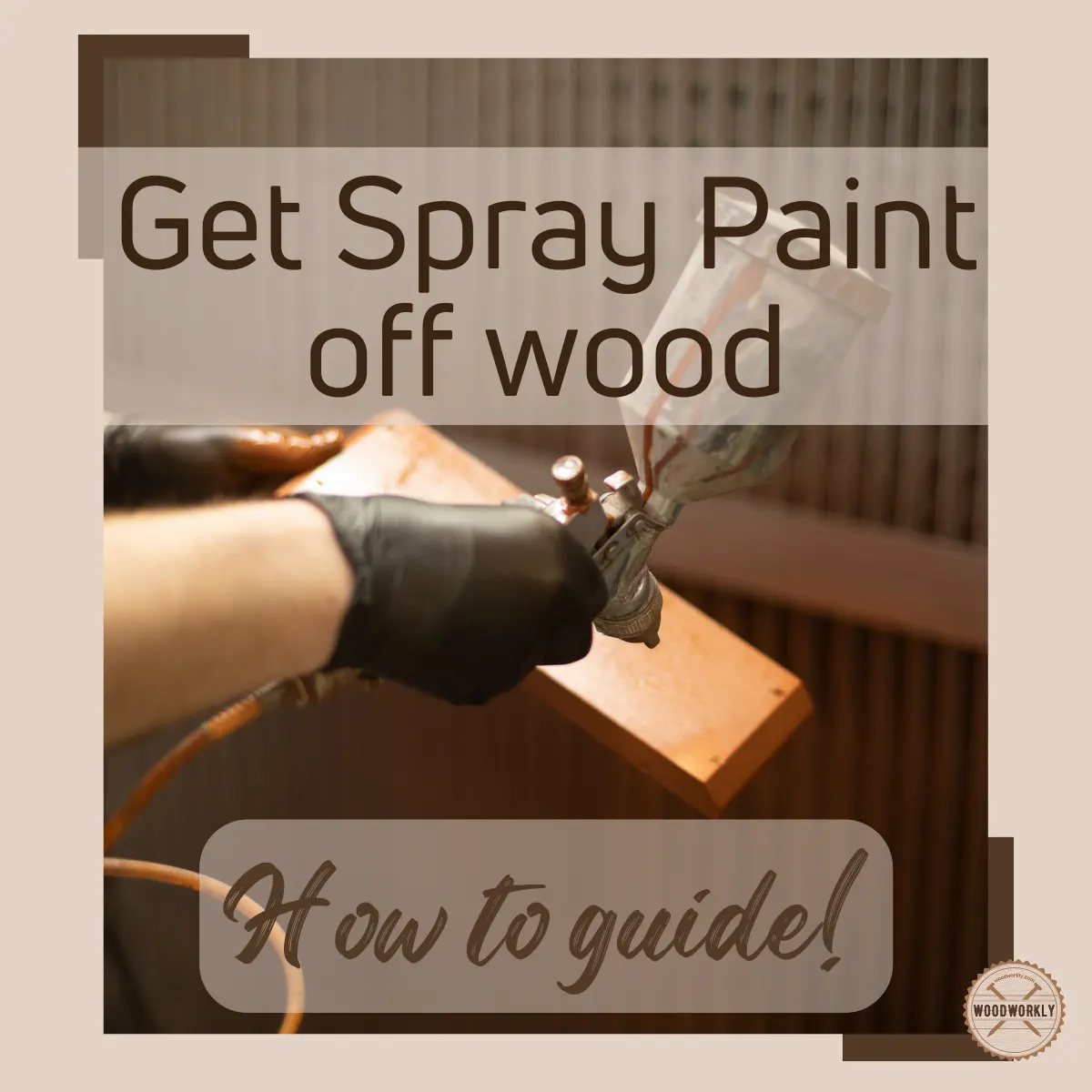
Are you worried about the accidental spray paints on your favorite wood furniture? Most DIY enthusiasts and artists face this problem.
I also had the same problem and I did deep research with the help of experts to find a solution. Now with years of experience, I have a good idea of what technique you should follow.
No worries further. I’m here to show you how to safely and effectively remove these accidental spray paint stains and restore the natural beauty of your wood surfaces using both household items and commercial products.
So, let’s find out, How to get spray Paint off wood?
To get spray paint off wood, apply a suitable solvent like soapy water, rubbing alcohol, or acetone to the spray-painted wood, depending on the paint type. Allow it to soak, then scrub or wipe the paint off. For stubborn paint, use a paint scraper or a heat gun. Always follow safety precautions and test a small area first.
But there’s a lot to know!

So, in this article, I’ll explore more techniques to remove spray paint from woods in detail. Plus, I’ll share some tips with you that I’ve learned over the past decade.
Furthermore, I’ll answer some frequently asked questions as well.
Let’s jump in!

Can you Get Spray Paint Off the Wood?
Yes, it is possible to remove spray paint from wood, although it could take some work and special techniques.
The technique you select will depend on the type of wood, the wood’s finish, and the degree of paint damage.
Read to know the Best Spray Paint For Wood!

Why Spray Paint?
Spray paint is a type of paint that comes packaged in a pressurized container. It is convenient to use for a variety of applications because it comes in aerosol cans.
Spray paint is renowned for its practicality, adaptability, and speed of drying.
Depending on the type of paint used and the surrounding conditions, spray paint dries quickly, frequently within minutes.
Spray paint is available in a wide variety of hues, textures, and effects, such as metallic, fluorescent, matte, glossy, and more.
It works on a wide range of materials, including wood, metal, plastic, glass, and more.
Spray paint is simple to use and allows for even coverage and smooth finishes.
Commonly spray paints are used for painting furniture, vases, or decorative items, for car touch-ups, and so on.

How to Remove Oil-Based Spray Paint?
It can be a little trickier to remove oil-based spray paint than water-based paints.
However, you can try rubbing alcohol, acetone, and chemical strippers to remove oil-based spray paints more effectively.
How to Remove Water-Based Spray Paint?
Water-based spray paint is relatively easier to remove than oil-based spray paint. First, you try warm soapy water.
If the water-based spray doesn’t come off with soapy water, try gentle abrasives like baking soda and other techniques which will be discussed below.
Methods to Remove Spray Paint from Wood
Getting spray paint off of wood might be difficult, but there are a few efficient techniques you can try.
Here, I am going to explain some techniques that you can try even at home in order to get spray paint off wood.
Here are the best methods to remove spray paint from wood,
- Soap and water
- Rubbing alcohol
- Mineral spirits
- Acetone
- Lacquer thinner
- Heat gun
- Paint scraper
- Paint strippers/ natural paint strippers
- Vinegar, lemon juice, or olive oil
- Baking soda
- Pressure washer
- Sanding
- Using Goo Gone Graffiti Remover
- Using Motsenbockers Lift-Off
Safety First!
Since the below methods utilize different chemicals and commercial products, it’s crucial to follow safety procedures when attempting to remove spray paint from wood to safeguard you, your children, and your pets.
Work outside in a well-ventilated area. Proper ventilation minimizes exposure to pollutants and allows any potentially hazardous vapors to evaporate.
Wear appropriate protective gear including a respirator or mask, gloves, safety glasses, or goggles.
Wear long sleeves and pants to protect your skin.
Pets and kids should not be allowed near the work area. Tools and chemicals might be dangerous for them.
Let’s see how to use the above-mentioned solvents, reagents, and tools to get spray paint off wood in detail.
1. Using Soap and Water
Is your paint a relatively fresh one? If so, simply you can apply this method and it might not be as effective for outdated or stubborn paint.

Supplies You Will Need
- Mild liquid dish soap
- Warm water
- Towels or rags
- Soft cloths or sponges
- Safety gear
Steps you need to follow when removing spray paint using soap and water,
Step 1: Create a Soapy Solution
Combine warm water and a few drops of mild liquid dish soap in a bucket. This soapy solution will aid in softer and easier paint removal.
Step 2: Soak and Rub the Painted Area
A soft cloth or sponge should be dipped into the soapy water, a bit squeezed out to prevent excessive dripping, and then used to gently rub the painted surface.
In a circular or back-and-forth motion, rub the painted surface. The paint will be broken down with the aid of soap and water.
Step 3: Repeat the Process If Necessary
If there are any remaining stain spots you will need to repeat the above process.
Step 4: Rinse and Dry
After removing the paint, thoroughly rinse the wood to get rid of any soap residue.
To completely dry the wood, use rags or fresh towels.
2. Using Rubbing Alcohol
Spray paint can be removed from wood with rubbing alcohol (isopropyl alcohol), especially if the paint is still relatively new.
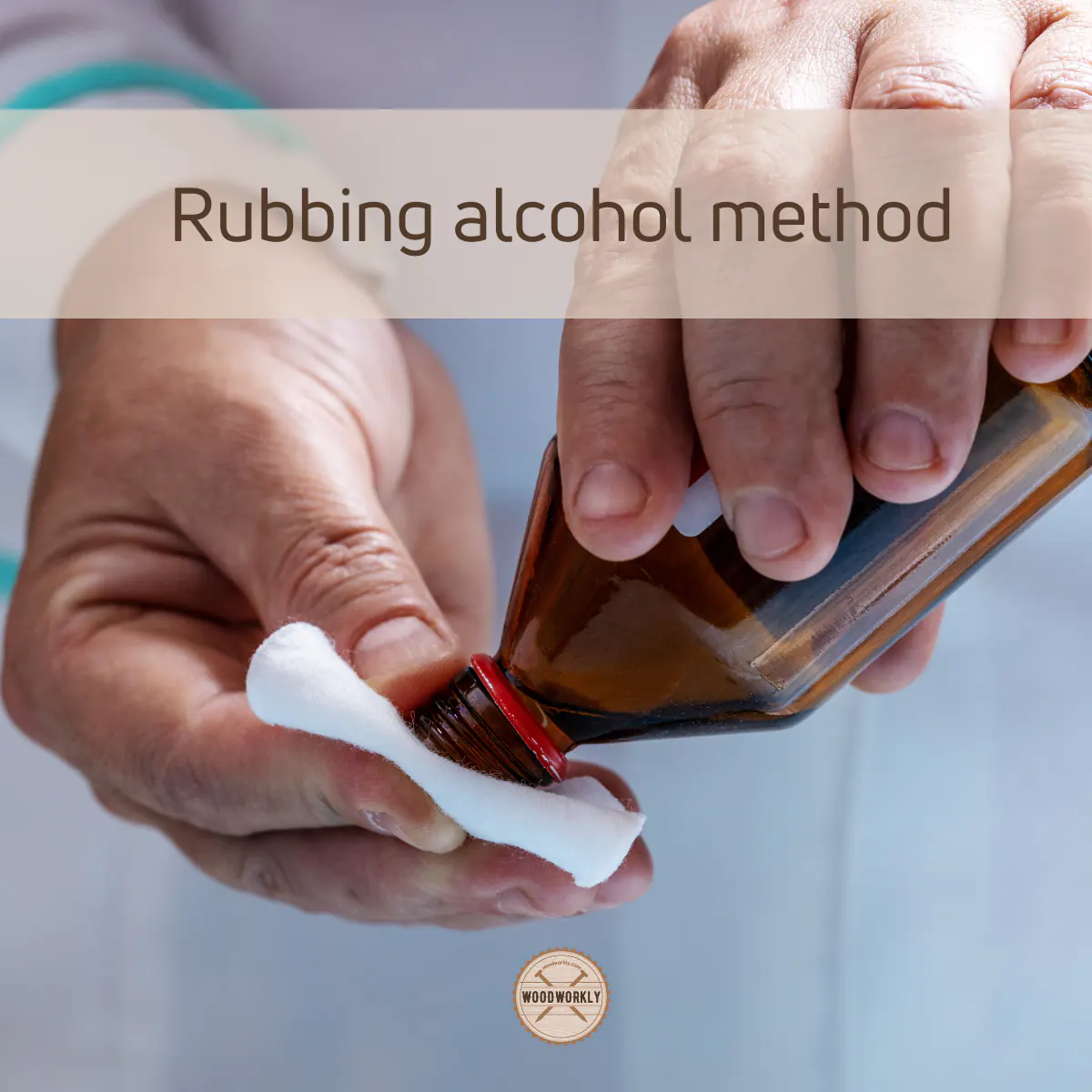
Supplies You Will Need
- Safety gear
- Rubbing alcohol (isopropyl alcohol)
- Clean water
- Towels or rags
Steps you need to follow when removing spray paint using rubbing alcohol,
Step 1: Apply Rubbing Alcohol
Pour a small amount of rubbing alcohol onto a soft cloth or paper towel.
Step 2: Rub the Area
Use a paper towel or cloth soaked in alcohol to gently rub the painted area. To aid in the breakdown and dissolve the paint, move in a circular or back-and-forth motion.
Step 3: Apply More Alcohol If Needed
Reapply rubbing alcohol as necessary if the cloth or towel becomes saturated or if there are stubborn paint stains.
Step 4: Rinse and Dry
After removing the paint, thoroughly rinse the wood to get rid of any rubbing alcohol or paint residue that remains on the surface and completely dry the wood, using rags or fresh towels.
3. Using Mineral Spirits
Spray paint can be successfully removed from wood with mineral spirits, especially oil-based spray paints.

Supplies You Will Need
- Safety gear
- Mineral spirits
- Soft cloths or rags
- A container
Here are the steps you need to follow when removing spray paint with mineral spirits,
- First, pour some amount of mineral spirit into a small container for your easy access.
- Apply a small amount of mineral spirits onto a soft cloth or rag.
- Use the above soft cloth or rag that has been soaked in mineral spirits to gently rub the painted area by a round or sweeping motion.
- Once the paint has been removed, rinse the wood surface with clean water to get rid of any residue.
Check out, Denatured Alcohol vs Mineral Spirits: Which is Better?
4. Using Acetone or Nail Polish Remover
Acetone is a powerful solvent that can be used to remove spray paint from wood, but you should use it carefully and with adequate ventilation because it is flammable.

Supplies You Will Need
- Safety gear
- Acetone or nail polish remover
- Soft cloths or rags
- Water
Here are the steps you need to follow when removing spray paint with acetone or nail polish remover,
- Apply acetone freely to the spray paint on the wood.
- After a few minutes of letting this set, soak an old rag in acetone or nail polish remover.
- Use the towel or rag that has been soaked in acetone to gently rub the painted area. Use a round or sweeping motion.
- Mop up whatever remains (dissolved paint and excess acetone) with more clean clothes that have been wetted.
- You can repeat the procedure as necessary if any paint smudges are left.
5. Using Lacquer Thinner
Lacquer thinner is a strong solvent that can effectively remove spray paint from wood.

Supplies You Will Need.
- Safety gear
- Lacquer thinner
- A plastic scraper
- Soft cloths or rags
- Clean water
Here are the steps you need to follow when removing spray paint with lacquer thinner,
- Apply a thick layer of lacquer thinner with a paintbrush to the spray-painted surface. Make sure the painted wood is completely covered.
- Allow it to sit for five minutes, or as long as the manufacturer specifies. This will soften the surface in order to assist in the easy removal of paint.
- Use a plastic scraper or putty knife to gently scrape the paint from the wood without damaging the wood.
- As necessary, add more lacquer thinner.
- If any lacquer thinner or paint residue remains on the wood surface, rinse it with clean water and dry it off.
6. Using a Heat Gun
Spray paint can be easily removed from wood with the help of a tool; the heat gun.
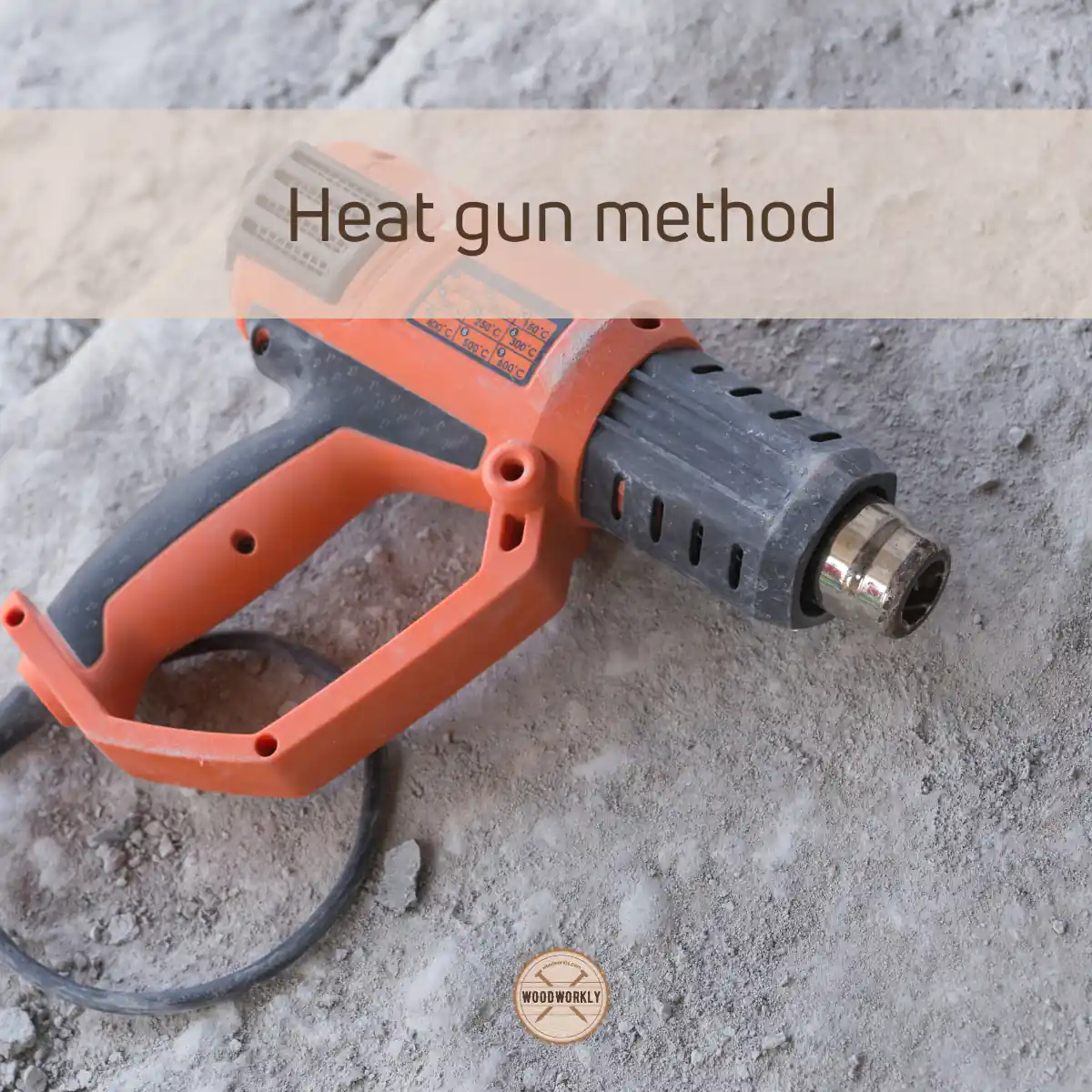
Supplies You Will Need.
- Safety gear
- Heat gun
- Scraper or putty knife
- Clean cloth or rag
- Clean water
Here are the steps you need to follow when removing spray paint with heat gun,
- Make sure the space is adequately ventilated before you start as mentioned above. Put on your gloves, mask, and goggles after that. For greater protection, choose leather gloves.
- The heat gun should be plugged in and set to a low to medium heat level. Place the heat source between 6 and 8 inches from the painted surface.
- Heat the spray paint gradually by sweeping the heat gun back and forth. You’ll see it beginning to bubble or soften as it warms up.
- Use a scraper or putty knife to carefully scrape off the softened paint while it happens. To prevent significant surface damage to the wood, work with the grain.
- Continue heating and scraping small sections at a time until you’ve removed as much paint as possible.
- Remove any residual softened paint or residue by using a clean cloth or rag.
- Rinse the wood surface with clean water after removing the paint to get rid of any remaining paint or cleaning residue.
7. Using a Paint Scraper
A paint scraper is used to remove paint or other coats from surfaces.
Usually, it consists of a handle and a flat, sharply-edged blade.

The blade is made to be thin and flexible while still being strong enough to remove paint, varnish, or other finishes off a variety of surfaces with little harm to the underlying material.
Supplies You Will Need
- Safety gear
- A paint scraper
Here are the steps you need to follow when removing spray paint with paint scraper,
- At the painted area’s edge, place the paint scraper and gently press down.
- Working along the direction of the wood grain can help to limit damage to the wood as you scrape away the paint from the surface.
- Wipe away the removed paint chips and other debris using a clean, dry cloth or rag.
- Repeat the process as necessary and wipe away the removed paint chips and other debris using a clean, dry cloth or rag.
If the paint is thick or difficult to remove, it could take some time and effort since it has to be done manually.
8. Using Paint Strippers/ Natural Paint Strippers
Spray paint can be removed from wood with a paint stripper, but for optimal results, applying it must be done carefully.
There are two main types of paint scrapers which are chemical paint strippers and natural or eco-friendly paint strippers, that can be chosen according to your preference.
You can choose a liquid stripper for horizontal surfaces, or a gel or paste stripper for vertical ones for ease of use.
Liquid chemical strippers are thin and dry quickly making less time to work the paint and therefore they are suitable for water-based or latex paints.
Gel strippers are thick and easy to apply and therefore they are excellent for removing more difficult oil-based paints.
As natural strippers, citrus-based or soy gel paint removers are popular among woodworkers.
Supplies You Will Need
- Safety gear
- Paint Strippers/ Natural Paint Strippers
- Soft cloths or rags
- Paint brush or a paint roller
Here are the steps you need to follow when removing spray paint with paint strippers,
- Using a paint brush or roller, evenly cover the painted area with the paint stripper.
- Allow the paint stripper to sit on the surface for the recommended time specified on the product’s label. This time may vary depending on the product and the paint type.
- After the paint stripper has softened, use a plastic scraper or putty knife to carefully scrape away the softened spray paint.
- To minimize the harm to the wood, work with the grain.
- Then, rinse the wood with clean water to get rid of any remaining stripper and neutralize any chemicals.
Read to know, How to Clean Acrylic Paint Brushes? (EASY Guide!)
9. Using Vinegar, Lemon Juice, Or Olive Oil
Spray paint can be removed from wood using natural and gentle methods like vinegar, lemon juice, and olive oil.

Even while they might not be as effective as industrial solvents or paint strippers, they can be effective for removing relatively recent paint spots without the use of harsh chemicals.
Supplies You Will Need
- Safety gear
- White vinegar, Lemon Juice, Or Olive Oil
- Soft cloths or rags
- Paint brush or a paint roller
Here are the steps you need to follow when removing spray paint with vinegar, lemon juice or olive oil,
- If you wish to use lemon juice, you need to combine equal parts of lemon juice with water or if you have olive oil or vinegar, take a generous amount of either olive oil or vinegar.
- Apply them on the painted area directly and stand it for about a few minutes.
- Use a plastic scraper or putty knife to carefully scrape off the softened paint after allowing the vinegar to soak the paint.
- Paint and leftover vinegar should be removed using a clean, dry cloth or rag.
- Then rinse with water and dry it off.
10. Using Baking Soda
Spray paint can be removed from wood with baking soda, which is a gentle and non-abrasive solution.
In comparison to more harsh chemical techniques, it is less likely to harm the wood.

Supplies You Will Need
- Safety gear
- Baking Soda
- Clean water
- Soft cloths or rags
- Paintbrush
Here are the steps you need to follow when removing spray paint with baking soda,
- Make a thick paste by combining baking soda and just enough water in a small container. Just the texture closely resembles toothpaste.
- Apply the baking soda paste to the painted section of the wood using a soft cloth or sponge with a light circular or back-and-forth motion.
- Wipe away any leftover baking soda and paint residue using a clean, moist cloth.
- To get rid of any leftover baking soda or paint, thoroughly rinse the wood surface with clean water and dry the surface.
11. Using Pressure Washer
A pressure washer can be used to remove spray paints on wood especially if you are working with a porous, untreated wood surface and plastic surfaces.

Supplies You Will Need
- Safety gear
- Pressure washer
- Appropriate nozzle for pressure washer
- Clean water
- Towels or rags
Here are the steps you need to follow when removing spray paint with paint washer,
Step 1: Set up the pressure washer
- Low pressure should be selected on the pressure washer at the beginning.
- Maintain a distance of 12 to 18 inches between the pressure washer nozzle and the wood surface.
- Depending on the settings and power of your pressure washer, the precise distance could change.
Step 2: Start applying
- Start with moving the nozzle from one end of the painted area to the other.
- To completely cover the painted area, move the nozzle back and forth in a sweeping manner.
- Whenever necessary, alter the spray patterns or raise the pressure gradually.
- Check the surface and repeat the process to completely remove the paint.
Step 3: After removing the paint, wash the surface with clean water and dry.
High-pressure or close proximity pressure washing might gouge or splinter the wood, causing damage.
12. Using Sanding
Is your wood surface consisting of thick or many layers of paint? If so, sanding is an effective method for removing spray paint from wood.
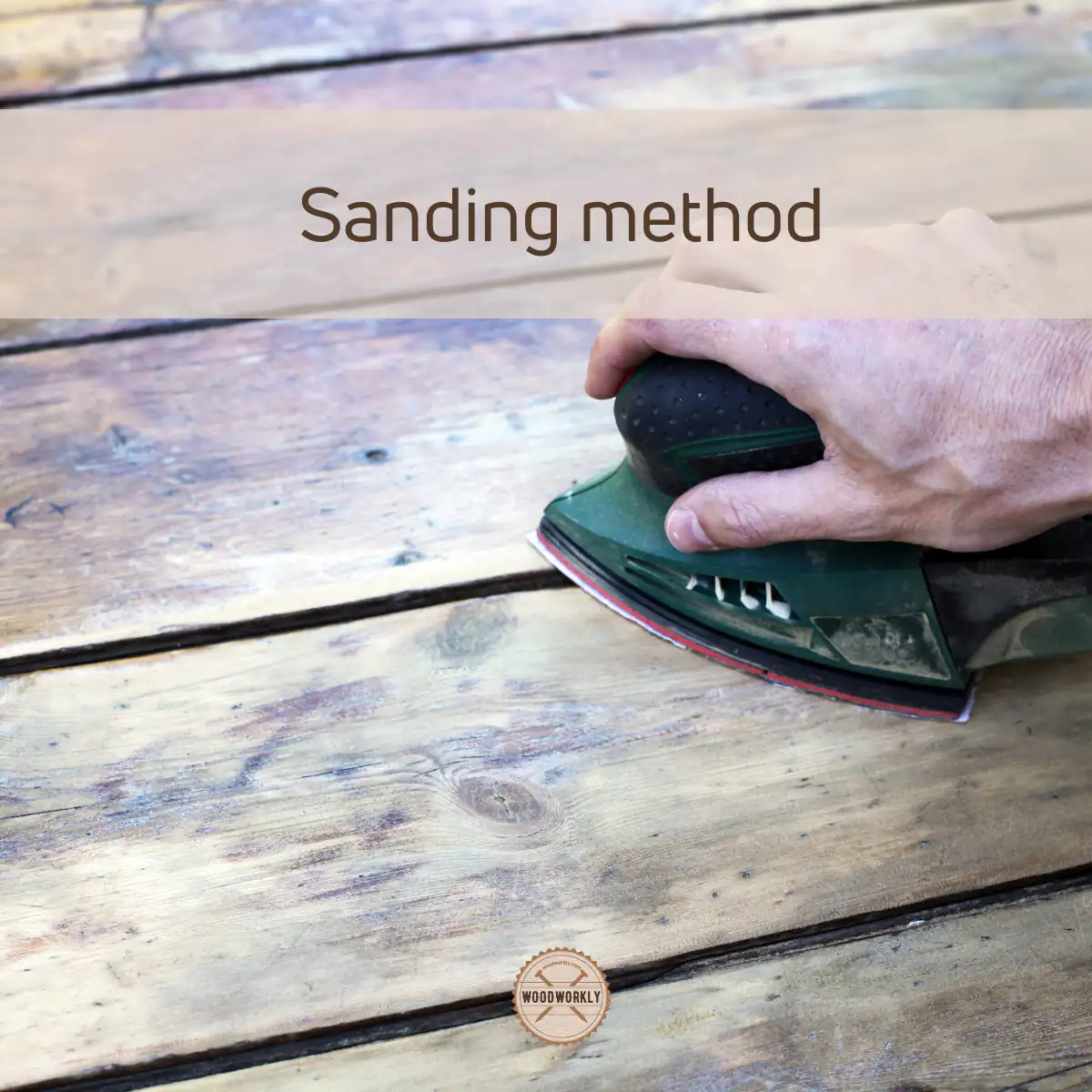
Supplies You Will Need
- Sandpaper or a power sander
- Safety gear
- Clean water
- Towels or rags
Here are the steps you need to follow when removing spray paint by sanding,
- Pick the right grit of sandpaper or abrasive pad according to your need. While a higher grit (such as 120-220) is preferable for smoothing and polishing the wood, a lower grit (such as 60-80) is suitable for removing thick layers of paint.
- If you use sandpaper, apply it manually or by wrapping it around a sanding block. When using a power sander, adhere to the directions provided by the manufacturer for the specific sander you have.
- Sand the painted area starting with the lowest grit sandpaper in a consistent, even motion along the direction of the wood grain with moderate pressure.
- After the majority of the paint has been removed, smooth the wood surface and remove any remaining paint residue with a higher grit sandpaper.
- Use a rag to wipe out all the debris and wash the surface with clean water if necessary and dry.
13. Use of Goo Gone Graffiti Remover
This product is a liquid paint remover and is more commonly used for decks, fences, and other large outdoor surfaces.
You will need,
- Safety gear
- Goo Gone Graffiti Remover
- Soft-bristled brush
- Clean rags
- Water or pressure washer
- Paint scraper
Here are the steps you need to follow when removing spray paint with Goo Gone Graffiti remover,
- Directly apply Goo Gone to the wood fence’s spray-painted surface.
- Allow it to stand for about five minutes
- Apply another coat and keep it for another 2-3 minutes.
- Use a paint scraper to scrape off the softened painted surface or you can directly use a pressure washer to remove paint from the surface.
- Apply pressure washer at an angle of 45 degrees and follow a sweeping motion.
- To ensure that all traces are removed, give the drying process 48–72 hours.
14. Use of Motsenbockers Lift Off
This type is commonly used for hardwood surfaces. Just be aware of the paint’s base and purchase your product accordingly.
Supplies you will need,
- Motsenbocker’s Lift Off
- Safety gear
- Plastic scraper or putty knife
- Clean clothes
Here are the steps you need to follow when removing spray paint with Motsenbockers Lift Off,
- Spray the Motsenbocker’s Lift Off Graffiti Remover directly onto the painted area of the wood.
- Before scraping and removing paint with a scraper, give it up to two minutes. The recommended amount of time to soften the paint may vary depending on the product’s specificity.
- To gently scrape off the softened paint, use a plastic scraper or putty knife.
- Repeat as necessary and wipe away all the traces with clean, wet cloths.
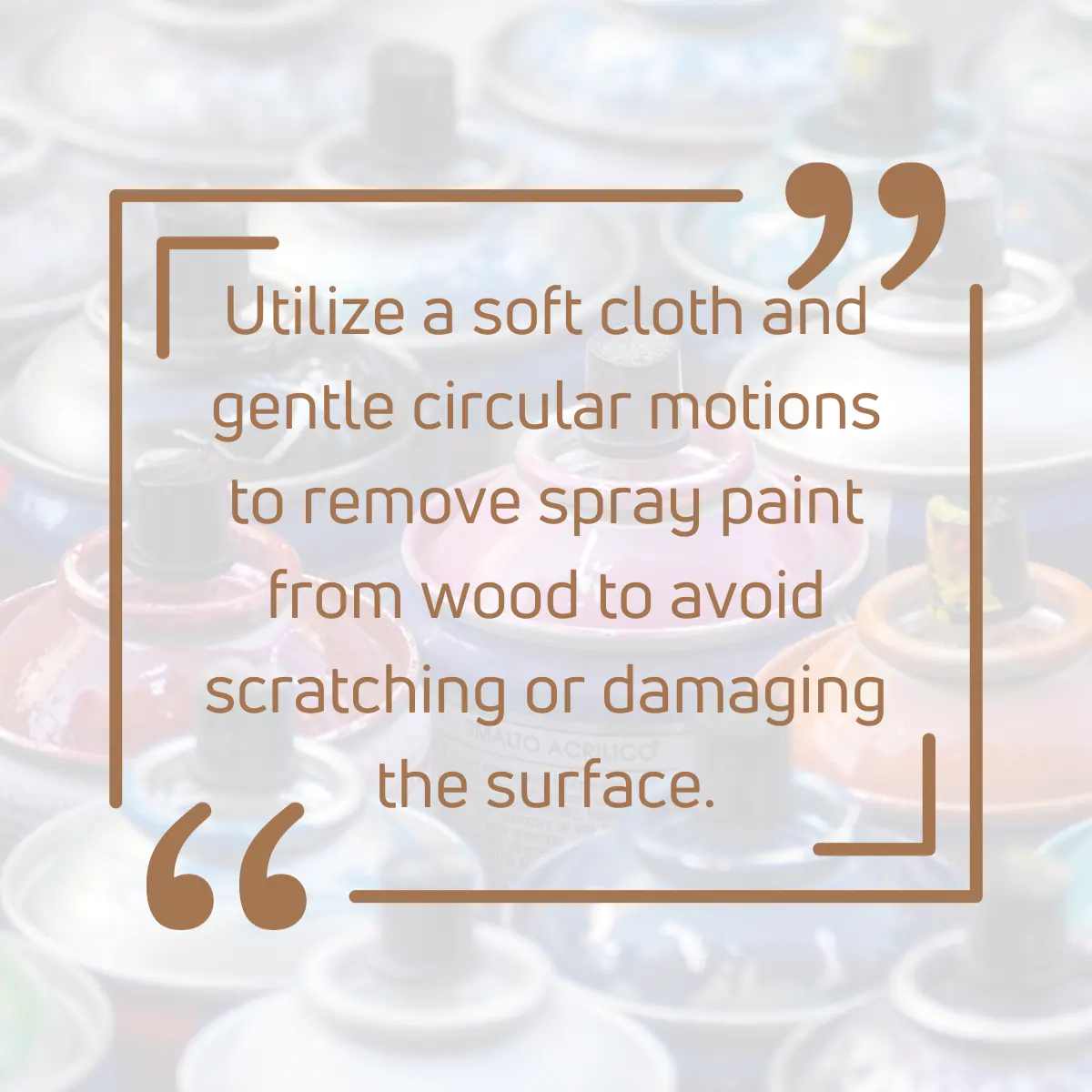
Commercial Spray Paint-Removal Methods
Several professional spray paint removal tools are available and are made especially for removing spray paint from wood surfaces more conveniently and efficiently.
Here are some commercial spray paint removal products that I can recommend,
- Krud Kutter Graffiti Remover
- Goof Off Graffiti Remover
- Goo Gone Graffiti Remover
- Motsenbockers lift off
Tips for Removing Spray Paint Off Wood
- Depending on the paint’s type, the wood’s surface, and your unique requirements, you need to choose the best paint removal technique.
- To simplify your work, gently scrape the painted surface using a plastic scraper or putty knife at the beginning and then apply the method.
- You can use an old toothbrush to scrub smaller or more complex grooves or places on wood for your ease.
- Always test a tiny, inconspicuous section of the wood first to ensure the method you are going to use won’t damage it or cause it to turn discolored. To prevent harming the underlying material, treat the wood with care and patience.
- The correct approach can vary depending on the wood and paint types because they may react differently to different removal techniques. So, you need to consider this as well.
That’s it, folks! Now you have a crystal clear knowledge about how to get spray paint off wood using different techniques.

So, let’s answer some frequently asked questions as well.
FAQs
Can I use soap and water to remove spray paint from wood?
Yes, a mixture of warm water and dish soap can be effective in removing water-based or latex spray paint from wood. Simply apply the soapy solution with a clean rag, scrub gently, and rinse.
Is rubbing alcohol safe for removing spray paint on wood?
Rubbing alcohol is suitable for cleaning latex-based spray paint from wood surfaces. Apply it generously, let it sit for a few moments, then scrub and wipe clean.
Can I use a heat gun to remove spray paint from wood?
Yes, a heat gun can be employed to remove thick layers of spray paint from wood by heating the paint until it bubbles and then scraping it off with a putty knife.
Can household items like olive oil be used for paint removal?
Olive oil can be applied to the painted area, left to sit for a few minutes, and then wiped away to effectively remove spray paint without damaging the wood.
Is lacquer thinner a quick solution for spray paint removal from wood?
Lacquer thinner is a powerful agent for removing spray paint quickly. Apply it with a brush, let it soften the paint, then scrape the paint off and clean the surface.
How does Goo Gone graffiti remover work on wood surfaces?
Goo Gone can be sprayed directly on the spray paint, left to sit, and then washed away with a pressure washer or hose, effectively removing the paint from wood fences and large outdoor surfaces.
Did I cover all you wanted to know about: How to Get Spray Paint Off Wood
In this article, I’ve deeply discussed how to get spray paint off wood in detail using various proper techniques.
Removing spray paints from wood can be done by using different solvents, commercial products, and sanding. You can apply solvents like acetone, or rubbing alcohol on the painted surface, let them for a few minutes, and then wipe off the debris by using clean rags. However, you need to choose the appropriate technique depending on the nature of the surface and paint type.
Plus, I’ve answered frequently asked questions as well.
Hope you learned everything you wanted to know about, how to remove spray paints off wood with experts’ tips.
Now it’s your time to select the method that suits you the most and remove spray paint from wood like a pro! Give them a try!